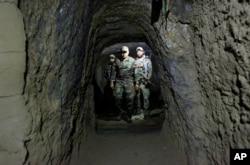Intensified efforts to root out and destroy the Islamic State terror group in Afghanistan are making progress in some areas but have so far failed to prevent the terror group from maintaining a foothold in the country, based on the latest U.S. intelligence estimates.
IS-Khorasan is thought to have more than 1,000 fighters, most of them located in Afghanistan's southern Nangarhar province, with a small number operating in the country's eastern Kunar province.
Those remaining loyal to IS's black flag include local Afghans, as well as fighters from Pakistan and Uzbekistan, a senior counterterrorism official told VOA, adding that IS-Khorasan fighters are believed to also be carrying out operations in Pakistan.
While U.S. defense and intelligence officials emphasize such numbers should always be viewed with caution, as counting terrorist fighters is far from an exact science, the estimates suggest IS-Khorasan fighters are finding ways to withstand U.S. efforts to wipe them out.
Those efforts included the use of the largest non-nuclear bomb in the U.S. arsenal, a GBU-43 Massive Ordnance Air Blast, to target what the Pentagon described as an extensive IS cave-and-tunnel system in Nangarhar province in April 2017.
Weeks later, also in Nangarhar, U.S. and Afghan forces killed the then-emir of IS-Khorasan, Abdul Hasib, following a three-hour firefight.
Hasib's replacement, Abu Sayed, was killed not much later in July 2017, at which point U.S. officials said IS's ranks in Afghanistan had been cut to 600, from a high of about 3,000 at the terror group's peak.
'Persistent' terror threat
Despite such efforts, there is seemingly little impact on IS-Khorasan's ability to carry out terror operations.
A report from the U.N. Mission in Afghanistan (UNAMA) found that through the first half of 2018, IS-Khorasan was responsible for more than 50 percent of civilian casualties, due to suicide bombings and other complex attacks.
In recent weeks, the terror group also claimed a series of attacks against Afghan Shiites, as well as high-profile attacks on Kabul itself.
"ISIS-K remains a persistent threat," Pentagon spokesman Colonel Rob Manning said Monday, using an acronym for the group. "We have eliminated several ISIS-K emirs and are relentlessly targeting their leadership hierarchy."
Afghan officials, though, are concerned such efforts may not be enough.
For months, they have warned IS-Khorasan has been bolstered by an influx of foreign fighters — first by a surge of about 3,000 from Pakistan and Uzbekistan, and later by hundreds of jihadists fleeing Iraq and Syria.
U.S. defense officials, including some familiar with border security measures that have been put in place by the U.S.-led coalition in Afghanistan and by Afghanistan's neighbors, are skeptical.
One official described the chances that large groups of IS-linked fighters could move freely across the border undetected as low.
Still, U.S. officials involved in the global campaign against IS warn that the terror group remains incredibly resilient, retaining key capabilities, even as its numbers shrink.
Afghan Taliban, IS-K rivalry
They also say IS-Khorasan has been especially savvy about turning local grievances to its advantage. And while some of the IS-Khorasan fighters are motivated by the terror group's ideology, many are also disgruntled former Taliban fighters looking for a bigger cut of the drug trade.
Over the past few months, it seems the United States may have been able to turn that rivalry to its advantage.
"The Taliban are fighting ISIS, and we encourage that because ISIS needs to be destroyed," said General John Nicholson, the commander of U.S. forces in Afghanistan.
In northern Afghanistan in Jowzjan province, in particular, the combination of what U.S. officials described as a series of "intensive operations" against IS-Khorasan, along with a Taliban ground campaign, appears to have paid off.
"All the northern provinces have been purged from Daesh militias," the Taliban announced earlier this month, using the Arabic acronym for the group.
About 250 IS-Khorasan fighters, along with their commander, Mawlawi Habib Rahman, are currently in Afghan government custody, where U.S. and Afghan officials say they will be prosecuted for their crimes "to the fullest extent of the law."
"I just think it speaks to the fact that our South Asia strategy has been working with the persistent pressure that's been placed on ISIS-K," Manning said. "They've only got a few options, and that is to surrender, or fight and die. And it looks like a lot of them are choosing the wiser option."
But such optimism is guarded. U.S. defense and intelligence officials are wary of declaring victory over a terror group that has found ways to repeatedly regroup and grow.
"There is hard fighting ahead. That's all there is to it," U.S. Defense Secretary Jim Mattis told Pentagon reporters Tuesday. "I don't declare victory until it's in the rearview mirror."









